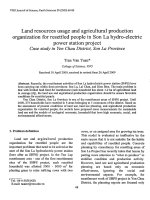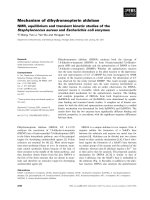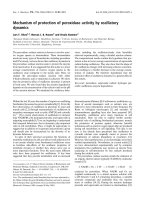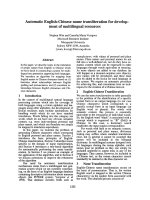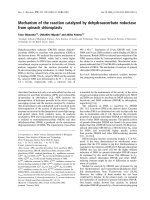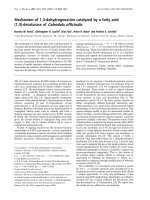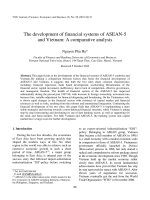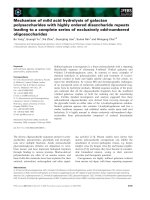Báo cáo " CLEAN DEVELOPMENT MECHANISM PROJECT DESIGN DOCUMENTS (CDM-PDD) FOR PILOT GRID-CONNECTED RICE HUSK-FUELLED BIO-POWER DEVELOPMENT PROJECTS IN MEKONG DELTA, VIETNAM " docx
Bạn đang xem bản rút gọn của tài liệu. Xem và tải ngay bản đầy đủ của tài liệu tại đây (326.78 KB, 16 trang )
1
CLEAN DEVELOPMENT MECHANISM
PROJECT DESIGN DOCUMENTS (CDM-PDD)
FOR
PILOT GRID-CONNECTED RICE HUSK-FUELLED
BIO-POWER DEVELOPMENT PROJECTS
IN MEKONG DELTA, VIETNAM
Nguyen Van Song
2
ABSTRACT
The research is designed for developing the pilot small-scale clean development
mechanism bundled project activities in Vietnam electricity/ energy sector. Its overall
purpose is to assess the potential of rice husk - fuelled bio-power development projects
in Mekong delta. Based on estimating the electricity potential of a bundle of rice husk-
fuelled bio-power development projects in Mekong delta with the capacity of 11 MW
per project, assessing their CO
2
emission reductions (CERs) and CER credits,
calculating and comparing their financial indices (NPV, B/C, IRR) in two cases - W/O
and W CDM, the research expects to recommend policies to use for bio-power
generation the unused rice husk that is dumped and discharged from local paddy milling
centers into rivers and canals, as well as, to put forward a safe and environmentally
friendly solution to minimize thoroughly the current serious pollution of rivers and
canals in Mekong delta with this increasing unused rice husk quantity.
Key words: Rice-huck, power plants, CO
2
emission reductions, Clean Development Mechanis.,
3
1. INTRODUCTION
Vietnam has an impressive economic growth rate, and success in transforming from
command economy to market economy, especially in transforming and developing its
agricultural sector.
The importance of the agricultural sector in Vietnam is profound, with a major impact
on employment, GDP and export. A continuing agricultural development generally and
a rapid paddy production growth particularly are very necessary.
Vietnam is divided into 8 socio- economic regions. Between these regions are large
differences in economic development generally and agricultural development
particularly. The Mekong Delta is the most important agricultural region amongst these
regions in the country.
While the Mekong delta occupied only 21% of national population and 12% of total
area of the country, its cereals planted area and cereals production generally, and its
paddy planted area and paddy production particularly, occupied up to 46% and 52% of
the whole country ones (Source: Vietnam Statistical Yearbook 2005).
The intensive paddy farming and rapid growth of rice production in Mekong delta leads
to dumping and discharging a large amount of rice husk from local dense milling center
network. The end-uses of rice husk discharged from milling centers are fuelling brick-
kilns, porcelain furnaces and rural household cooking (not to be considerable - under
20% of total), open air burning for fertilizing the planted areas (not to be considerable -
under 20% of total), and dumping (to be uncontrollable- over 70%) (See the following
Vietnam’s and Mekong delta’s Rice Husk Potential and Availability Flowchart, and the
Statistical Yearbook 2005).
Because almost all of paddy milling centers in Mekong delta are located on the banks of
canals and two major rivers - Tien river and Hau river in order to take advantage of
local dense water transport network, unused rice husk dumped by milling centers is
discharged into the Mekong delta's dense canal system, that provoke the serious
pollution of local canals and rivers with increasing dumped rice husk amount. With
Mekong delta's dumped rice husk quantity amounting to 1,400,000 tons per year, the
uncontrollable dumping of unused rice husk discharged from dense milling center
network into canals and rivers provokes serious negative environmental impact to have
to be resolved. Amongst three rice husk disposal modes - open air burning of rice husk
for fertilizing the planted areas, uncontrollable dumping of unused rice husk into rivers
and canals, and rice husk-fuelled bio-power generation, the last one is selected as the
most economically feasible and environmentally friendly solution in the context of
Government and local priorities given to renewable electricity generation technologies
and rural electrification in Mekong delta
.
Pham Khanh Toan, Nguyen Van Hanh and Nguyen Duc Cuong (Institute of Energy)
have elaborated in 2005 the quantitative study on the Feasibility of Using the Solar
Energy, Mini-hydro power and Biomass Energy in Vietnam. The study provided a
comprehensive overview on three main types of renewable energy in Vietnam – Solar,
Mini-hydro power and Biomass energy, in that, the using rice husk and bagasse to fuel
the bioelectricity generation is first considered in details on not only the qualitative but
also the quantitative basis (Chapter 2-2.4 and Chapter 4-4.2). The preliminary data and
analysis of the study on the rice husk potential in Mekong Delta (South-Vietnam) are
very useful for preparing the CDM-PDD of 11 MW rice husk-fuelled biopower plant
4
and policy recommendations for using the rich rice husk potential of provinces in
Mekong Delta[2].
Randall Spalding –Fecher in 2002 has edited the CDM guidebook-a resource for CDM
project design developers in Southern Africa. The book directed at smaller scale local
partners in Clean Development Mechanism projects to empower them to put forward
project ideas, particularly ideas with a development focus. The book bridged the gap
between general introduction to CDM and more technical manuals on project design
and greenhouse gas assessment. On monitoring and verification, it summarizes
monitoring protocols and does provide a comprehensive overview of how to get a
design and report on a small-scale CDM projects[4,5].
Robert T.Watson, Marufu C. Zinyowera and Richard H. Moss in 1996 have provided an
overview and analysis of technologies and measures to limit and reduce greenhouse gas
(GHG) emissions and to enhance GHG sinks under the UNFCCC. Their paper focuses
on technologies and measures for the Annex I countries, while noting information as
appropriate for use by non-Annex I countries. The paper includes discussions and
recommendations on technologies and measures that can be adopted in three main
energy and end-use sectors (commercial/ residential/ institutional buildings,
transportation and industry) as well as in sectors of energy supply, agriculture, forestry
and waste management in not only the Annex I but also the non-Annex I countries[6].
The study of Thipwimon Chungsangunsit, Shabbir H. Gheewala and Suthum
Patumsawad in 2004 shows that the emissions of SO2 and NOX are lesser in case of
coal and oil-fired power generation, but higher than for natural gas. The emission of
CO2 from combustion of rice husk are considered zero since they do not contribute to
global warming. CO and dust emissions are slightly higher than conventional power
production pointing to need for improving the combustion efficiency of the rice husk
power plant. Overall, the study indicates that rice husk is a viable feedstock for
electricity production and performs better than fossil fuels (especially coal and oil) from
the point of view of environmental emissions[7].
Y. Hofman. 2004. conducted on study on a small scale project design document
biomass Rajasthan. The project involves the implementation of a biomass-based power
generation plant using direct combustion boiler technology. The installed capacity of the
plant is 7.8 MWel. The fuel used is primarily mustard crop residue, which is abundantly
available in the vicinity of the site. The electricity generated will be sold primarily to the
state grid with the balance sold to third parties (large industrial customers). The
generated electricity will replace a mixture of coal and gas-based power generation. The
total amount of CERs to be delivered is expected to be 313,743. The implementation of
the project will also lead to additional income and employment in the region
(approximately 150,000 man days of work per year1). [8]
Objectives: The principal goal of the research is to assess the CDM potential of rice
husk - fuelled bio - power development projects and to recommend a regional strategy
to develop a bundle of rice husk - fuelled bio-power development projects of 11 MW
installed capacity per project for minimizing the uncontrollable dumping of unused rice
husk discharged from local dense paddy milling centers to rivers and canals in Mekong
delta.
5
2. RESEARCH METHODS
2.1. Data collection
the rice husk availability on the basis of estimating the rice husk potential of
milling centers located alongside Tien Giang river in Mekong delta.
• the capability to transport in most economic manner (water way) the rice husk
needed by not only the considered pilot rice husk-fuelled bio-power plant but
also the future similar ones planned at Mekong delta;
• the current local rice husk using and pricing.
Interviewing the relevant companies and stakeholders:
• the willingness to participate in the pilot Project of current local milling centers
in capacity of Project developers.
• the willingness to sell the stored rice husk, the rice husk selling capability and
the acceptable rice husk pricing level of current rice milling centers.
• the steady rice husk availability and procurement for bioelectricity generation in
provinces of Mekong delta (South - Vietnam).
2.2. Calculation of GHG emissions by sources
2.2.1. Project emissions:
CO
2
from on - and off-site transportation.
CO
2
from start-up/auxiliary fuel use.
a) Biomass electricity generation
Annual CH
4
released
=
Heat value of rice
husk used by
Project
×
Methane emission factor
for rice husk combustion
×
GWP of CH
4
(tCO
2
e/yr) (TJ/yr) (tCH
4
/TJ) (tCO
2
e/tCH
4
)
b) Transportation of biomass
Distance
traveled
=
Total rice husk
consumed by project
÷
Truck
capacity
×
Return trip distance
to supply site
(km/yr) (t/yr) (t) (km)
Emission
factor
=
CO
2
emissio
n factor
÷
CH
4
emission
factor
×
GWP of
CH
4
+
N
2
O
emission
factor
×
GWP of N
2
O
(tCO
2
e/km)
(tCO
2
/k
m)
(tCH
4
/km)
(tCO
2
e/tC
H
4
)
(tN
2
O/km) (tCO
2
e/tN
2
O)
Annual emission
=
Emission factor
×
Distance traveled
(tCO
2
e/yr) (tCO
2
e/km) (Km/yr)
c) Start-up/auxiliary fuel use
6
• For residual oil:
CO
2
emission
factor
=
C emission
factor
×
Fraction of C
oxidized
×
Mass conversion
factor
(tCO
2
/TJ) (tC/TJ) – (tCO
2
/tC)
• For CH
4
and N
2
O
Emission
factor
=
CO
2
emission
factor
+
CH
4
emission
factor
×
GWP
of CH
4
+
CO
2
emission
factor
+
N
2
O
emissi
on
factor
×
GWP of
N
2
O
(tCO
2
e/TJ)
(tCO
2
/TJ)
(tCH
4
/TJ)
(tCO
2
e
/tCH4)
(tCO
2
/TJ)
(tN
2
O/
TJ)
(tCO
2
e/
tN
2
O)
• For fuel consumption in energy equivalent
Fuel consumption in
energy equivalent
=
Fuel oil (FO)
consumption
×
Net calorific
value of FO
×
Density of
FO
(TJ/yr) (L/yr) (TJ/10
3
t) (t/L)
•
Annual Emission
=
Emission factor
×
Fuel consumption in energy
(tCO
2
e/yr)
(tCO
2
e/TJ)
(TJ/yr)
d) Describe the formulae used to estimate anthropogenic emissions by sources of
greenhouse gas in the baseline using the baseline methodology for the applicable
project category in appendix B of M & P:
Where: E
j
= CO
2
emissions per year of the generation mode j, calculated as:
Where: PG
j
= electricity generation of power plant j;
EF
j
= emission capacity of the fuel-fired power plant j;
OF
j
= oxidation factor
CF = unit conversion factor: 44/12 (C – CO
2
) x 0.36 (TJ – MWh);
TE
j
= thermal efficiency of the electric generation mode j
Weighted average emission (E), representing the emission intensity, is given by:
Where: E is given by equation (1); PG (MWh/yr) = ∑
j
PG
j
(MWh/yr)
The emission intensity coefficient, (E)
baseline,
is thus obtained as:
E (ton CO
2
/yr) = ∑
j
E
j
(ton CO
2
/yr) (1)
E
j
(ton CO
2
/yr) = PG
j
(MWh/yr) x EF
j
(ton C/TJ) x OF
j
x CF/TE
j
(%) (2)
(E) (ton CO
2
/MWh) = E(ton CO
2
/yr)/PG (MWh/yr) (3)
(E)
baseline
(ton CO
2
/MWh) = {(E)
operating margin
(ton CO
2
/MWh)
+{(E)
build margin
/ (ton CO
2
/MWh)}/2 (4)
7
Finally, baseline emissions are given by:
2.2.2. Estimating the anthropogenic emissions by GHG sources of baseline.
a) Grid electricity generation.
CO
2
emission
from
grid
=
Grid fuel
consumption
×
Net
calorific
value
×
C
emission
factor
×
Fraction
of C
oxidized
×
Mass
conversion
factor
(tCO
2
)
(10
3
t)
(TJ/10
3
t)
(tC/TJ)
–
(tCO
2
/tC)
CO
2
emission
factor
=
Sum of all CO
2
emission from
grid
÷
Grid Electricity
generated
(tCO
2
/MWh) (tCO
2
) (MWh)
CO
2
emission displaced by
Project
=
Electricity exported by
Project
×
CO
2
emission
factor
(tCO
2
/yr)
(MWh/yr)
(tCO
2
/MWh)
b) Open air burning for biomass disposal
Carbon
released
=
Rice husk use as fuel by the bio
-
power plant
×
Carbon fraction of
biomass
(tC/yr) (t biomass/yr) (tC/t biomass)
Annual CH
4
released
=
Carbon
released in
total
×
Carbon
released as
CH
4
in open-
air
×
Mass
conversion
factor
×
GWP of CH
4
(tCO
2
e/yr)
(tC/yr)
(%)
(tCH
4
/tC)
(tCO
2
e/tCH4)
c) Baseline emissions summary
CO
2
emission from grid
electricity
+
CH
4
emission from open air
burning of rice husk
=
Total baseline
emissions
(tCO
2
/yr) (tCO
2
e/yr) (tCO
2
e/yr)
2.2.3 Difference between 2.2.1 and 2.2.2 representing the emission reductions of
project activity.
Emission
reduction
=
Emission
from grid
electricity
generation
+
Emission
from
open air
burning
for rice
husk
disposal
–
Emission
from
biomass
fuelled
electricity
generation
–
Emission
from
transportation
of rice husk
for the
Project
–
Emission
from
fuel oil
use for
the
Project
(start-up)
2.2.4. Emission reductions of Project activity.
Total baseline emissions
–
Total Project emissions
=
Emission reductions
(tCO
2
/yr) (tCO
2
e/yr) (tCO
2
e/yr)
E
baseline
(ton CO
2
/MWh) = (E)
baseline
(ton CO
2
/MWh) x CG (MWh/yr) (5)
8
2.3 Benefit cost analysis
• Total cost including:
C
t
= C
t inv.
+ C
t O & M
+ C
t fuel (RH)
C
t inv.
= investment cost
C
t O & M
= operation and maintenance cost
C
t fuel (RH)
= fuel rice husk cost (including rice husk transport and storage
costs).
• Total benefit including:
B
t
= B
te
+ B
tCER
+ B
ash
B
te
= Benefit given by rice husk electricity sale = p
e
Wt;
B
tCER
= Benefit given by CER sale = p
CO2
CER;
B
t ask
= Benefit given by rice husk ash sale = p
ash
W
t
;
P
e
= rice husk electricity sale price;
p
CO2
= CER sale price;
p
ash
= rice husk ash sale price;
W
t
= rice husk electricity sale to EVN grid in year "t";
3. RESULTS AND DUSCUSIONS
3.1. ASSESSMENT OF THE CO
2
EMISSION REDUCTIONS (CERs) AND CER
CREDITS DETERMINED BY DIFFERENT ASSUMED CO
2
PRICES
Assessment of the CO
2
emission reductions (CERs) and CER credits determined by
different assumed CO
2
prices is realized for a bundle of five similar pilot grid connected
rice husk-fuelled bio-power development projects 5
×
11 MW installed capacity. As
presented in previous part 3, these five identified and recommended power projects are
similar regarding their size and employed technology. And although they are originally
presented as a single CDM project, this comprises five similar rice husk power projects
with the installed capacity of 11 MW per project. The assessment of their CERs and
CER credits will be carried out only for an individual rice husk power project then its
assessed CER and CER credit will be multiplied with 5 to make the CER and CER
credit of the whole CDM project.
3.2 IRR, NPV, B/C) OF THE RICE HUSK-FUELED BIO-POWER PROJECTS
IN TWO CASES: WITHOUT CDM AND WITH CDM
Calculation and comparison of IRR, NPV and B/C in two cases - W/O CDM and W
CDM are carried out with four major input parameters (Table 1) namely:
o Unit investment costs of proposed rice husk power project, namely 1,350;
1,570; and 1,700 US$/Kw ;
o Electricity sale prices of proposed rice husk power project, namely 0.04;
0.05; 0.06; and 0.07 US$/KWh;
o CO
2
sale prices of proposed rice husk power project namely O (W/O CDM);
3 ( W CDM); 9 (W CDM); and 15 (W CDM) US$/ton of CO
2e
.
9
o Rice husk ash price of proposed rice husk power project to be assumed as at
constant pricing level of US$ 0.02/t of ash.
Calculation and comparing of IRR, NPV and B/C ratios are carried out for 2
cases: with maximal running day number(332 days/year)(as above), and average
running day number(200 days/year)(realistic case) based on realistic input
parameters,namely1350 and 1579US$/KW;0.04,0.045 and0.05US$/KWh;0,3,9
and15US$/TCO2
4. RECOMMENDATION OF POLICES ON THE DEVELOPMENT OF
REGION-WIDE USE OF RICE HUSK FOR BIO-ELECTRICITY
GENERATION IN MEKONG DELTA
4.1 Context
Consideration of current serious pollution of Mekong delta's rivers and canals with
unused rice husk dumped and discharged from local paddy milling centers shown great
region-wide environmental threat to the health of local communities and their
livelihood, especially their traditional aquaculture and pisciculture. This region-wide
environmental threat will be rapidly increasing with following context:
• Increasing paddy production and rice export is the most important long term
economic development orientation of Mekong delta, that lead to rapidly increase the
local rice husk generation.
• Basic change in traditional rice husk end-uses of local communities from using the
rice husk fuel to using the commercial energy types for rural household cooking,
fuelling their brick-kilns, pottery and porcelain furnaces, food processing etc., that
leads to rapidly reduce the local rice husk consumption and increase the local
unused rice husk dumping.
• Without a region-wide cooperation in looking for an environmentally friendly and
effective solution to thoroughly minimize the pollution of Mekong delta's rivers and
canals with unused rice husk dumped and discharged by paddy milling centers.
From the year 2004, the seeking for a thorough solution to minimize the increasing
pollution of rivers and canals with rice husk discharged from paddy milling centers in
Mekong delta became an urgent task faced by local authorities, administrators,
agriculture and energy development planners. Safe and environmentally friendly
disposal of 3.7 millions tons of rice husk per year with over 70% of that (2.5 millions
tons per year) to be dumped is one of major problems of Mekong delta's sustainable
development.
In this context, the development of a bundle of 5 rice husk-fuelled bio-power projects
with an installed capacity of 5 × 11 MW has been selected as the most thorough and
sustainable solution to solve this problem.
10
4.2 Recommendations of Polices to Develop the Region-wide Use of Rice Husk
for Bio-Electricity Generation in Mekong Delta
6.2.1 View points and Overall Orientations
• Increasing pollution of Mekong delta's rivers and canals with unused rice husk
dumped by local milling centers should be considered as a great region-wide
environmental threat to all of 13 provinces in this region.
• Rice husk-fuelled bio-electricity generation should be considered as the most
effective and environmentally sustainable solution to thoroughly minimize the
current increasing pollution of local rivers and canals with unused rice husk to be
dumped and discharged into their water flows
• Region-wide development of rice husk-fuelled bio-electricity generation should be
planned with a bundle of rice husk power projects.
• Siting rice husk power projects in the whole Mekong delta plays the role of decisive
importance. Locations of these projects should be selected on the basis of satisfying
following siting criteria: convenient places for waterways (local rivers, canals) -
based rice husk collection and transport, places having dense local paddy milling
center network within a radius of 30 km maximally, places to bear intensive
pollution of rivers and canals with rice husk dumping.
Based on above viewpoints, the research recommends to develop in Mekong delta a
bundle of five (5) similar pilot rice husk-fuelled bio-power projects having a total
installed capacity of 5
×
11 MW at five locations, namely: AN HOA (An Giang
province), THOI HOA (limitrophe area of 3 provinces - An Giang, Dong Thap and Can
Tho), THOI LAI (Can Tho province), CAI LAY (Tien Giang province) and TAN AN
(Long An province). Besides these five locations, a reserved location in TAN CHAU
(limitrophe area of 2 provinces - An Giang and Dong Thap, and the Kingdom of
Cambodia) is selected for the future development of paddy milling center network as
well as, of rice husk power centers (See the Vietnam Rice Husk and Rice Husk
Electricity Potential and Availability Flowchart, and Mekong delta's map).
4.2.2 Technological Identification, Orientation and Selection
• Technology to be employed
Rice husk burning in the grate boiler and/or the suspension-fired boilers is designed
to burn ground rice husk in grate and/or suspension with ability to produce high
quality ash product, which will be suitable as a substitute ingredient for local
cement.
• Maturity of employed technology
It is a state-of-the-art technology in Vietnam that will be first transferred to
Vietnamese energy/electricity experts.
11
4.2.3 Contribution of the bundle of 5 similar pilot rice husk-fuelled bio-
power development projects of 5 ×
××
× 11 MW installed capacity to the
sustainable development in Mekong delta
• Potential of rice husk fuel represents particularly rich renewable energy source for
the Mekong delta that will be first thoroughly used for sustainable energy
development, especially for local rural electrification in this region.
• In capacity of one of most important biomass renewable sources in Mekong delta,
the projects will provide electricity through rice husk power production without
relying on fossil fuel combustion and are placed at the top of the list of promising
CDM project areas for Vietnam generally, and for Mekong delta particularly.
• Technology to be employed will eliminate the environmental issues of unused rice
husk and ash disposal, while at the same time reduce GHG emissions from cement
manufacturing.
4.2.4 Orientations to select the suitable mode of rice husk disposal in
Mekong delta
• Following modes of rice husk disposal are identified and investigated for Mekong
delta:
o Fuelling;
o Open air burning;
o Dumping and discharging into local rivers and canals (over 70%), and provoking
the pollution of their water flows with dumped rice husk;
• Criteria of selecting the suitable mode of unused rice husk disposal and of seeking
for an appropriate solution to minimize the pollution of rivers and canals with
unused rice husk discharged from paddy milling centers in Mekong delta
o Thoroughness of selected solution
o Environmental sustainability of selected solution
o Economic-financial feasibility of selected solution
The rice husk-fuelled bio-power development is selected as the most appropriate
solution for Mekong delta because this solution could satisfy all of above criteria.
4.2.5 Economic-financial policies recommended for the region-wide development
of rice husk-fuelled bio-power projects in Mekong delta
• Inter- provincial investment co-operation is very necessary for the development of
rice husk power projects in Mekong delta;
• Granting subsidy for small renewable (rice husk) power producers (grid-connected
or off-grid) from central and local governments was a major policy of the
government and this policy should be concretized by detailed decrees for the case of
rice husk power plants in Mekong delta.
12
• Prices of electricity generated by rice husk power plants and sold to EVN through
national power grids should be considered by the government and EVN with the
concession of electricity pricing to small renewable (rice husk) power producers, so
that EVN could agree to purchase the rice husk electricity with the electricity
pricing level from US$ 0.045 to US$ 0.050 per KWh.
4.2.6 Policies recommended for training and technology transfer
• Staff training and technology transfer of the state-of-the-art rice husk combustion
and rice husk power generation technology are the most important way for
providing the necessary knowledge and experiences for project designing, operation
and management;
• Training on job-specific subjects and on-the-job training should be considered as the
important supplementary training items for the staff.
• CDM-PDD Version 03 used for rice husk-fuelled bio-power projects should be an
indispensable part of training program for Vietnamese energy/electricity planners
and managers.
5.
CONCLUSION
Rice was always Vietnam's most important agricultural product, with Vietnam being
one of largest rice exporters in the world. From 2000 to 2004, the Vietnam's average
yearly paddy production was about 34 million tons a year, with a general increase of
about 2.5% per year. Great agricultural achievement of Vietnam resulted from the
contribution of all of eight (8) socio-economic regions in the country, first of all, of the
Mekong delta. Indeed, Mekong delta is the richest alluvial plain with an extensive and
dense network of rivers and irrigation canals. While, Mekong delta's rice husk supply is
stably increasing, there is low demand for rice husk in this region. About 30% of
Mekong delta's rice husk (over 1 million tons per year) is used as fuel by brick kilns,
pottery/porcelain furnaces, food processing, rural household cooking etc., currently over
70% of Mekong delta's rice husk (2.4 ÷ 2.6 million tons per year) is unused ,dumped
and discharged into local rivers and canals.
Increasing pollution of Mekong delta's rivers and canals with unused rice husk
discharged from extensive and dense network of paddy milling centers became an
environmental danger to the health and livelihood (aquaculture and pisciculture) of
Mekong delta population. Seeking for a safe and environmentally friendly solution to
thoroughly minimize this environmental danger is an urgent task faced by Mekong
delta's provincial people's committees, agriculture, industry and energy development
planners, policy makers and managers.
The research has established the Vietnam's and Mekong delta's Rice Husk and Rice
Husk Electricity Potential and Availability Flowchart. Based on this flowchart the
research has shown that:
• In total calculated rice husk potential of the whole country of over 7 million tons in
year 2004, the calculated rice husk potential of only Mekong delta amounted to over
3.7 million tons and occupied a share of over 50% of total. And 7/13 Mekong delta's
provinces are identified as rice husk procurement areas of rice husk power projects
13
with their calculated rice husk potential of 2.374 million tons in year 2004; and 60%
of this potential (1.420 million tons) are unused rice husk.
• Potential of the rice husk-fuelled bio-power development projects is estimated with
the planned rice husk potential procurement and availability of 1.420 million ton
from local paddy milling centers for proposed rice husk power plants.
• Research recommends to develop a bundle of five (05) similar rice husk power
projects of 5 × 11 MW installed capacity, namely AN HOA (An Giang province),
THOI HOA (neigboring area of 3 Mekong delta's provinces - An Giang, Dong
Thap, Can Tho), THOI LAI (Can Tho province), CAI LAY (Tien Giang province)
and TAN AN (Long An province).
The above bundle of five similar rice husk-fuelled bio-power projects is categorized as
the Renewable energy project: Grid-connected rice husk electricity generation,
therefore, their CO
2
emission reductions (CERs) and CER credits determined for the
period 2006 - 2025 by different assumed CO
2
prices have been assessed for proposed
rice husk power projects with following results:
During the plant life of 20 years (2006 - 2025), the average annual CER of a proposed
rice husk power project will be of 26,700 ton of CO
2e
with TOU=4,800 hours/yr( or 200
operating days per year), and its average annual CER credits by CO
2
prices of US$ 9
and 15 per ton of CO
2e
will be from 240 to 400 thousand US$ respectively. For the
whole bundle of five (5) similar rice husk power projects of 5
×
11 MW installed
capacity, these figures will be of 5x26,700= 133,500 tons of CO
2e
per year; and 1,200-
2000 thousand US$ per year, respectively.
Conclusions drawn from calculations and comparisons of IRR, NPV and B/C in two
cases- W/O and W CDM are following:
• Amongst three major input parameters - rice husk electricity sale price, unit rice
husk power investment cost and CER credit, while two first parameters play the
predominant role, the last parameter - CER credits plays a limited positive role.
• Rapid increase in CO
2
pricing level, however, plays a inconsiderable positive role
in increasing the values of IRR, NPV and B/C ratio of proposed rice husk power
projects.
Based on above analysis, the research recommends necessary policies on the
development of region-wide use of unused rice husk for bio-electricity generation in
Mekong delta, namely:
• To select the development of region-wide use of unused rice husk for bio-electricity
generation in Mekong delta as the most important mode of safe and environmentally
friendly rice husk disposal for this region.
• To consider the region-wide rice husk electricity development as an indispensable
part of a medium-term rural electrification program for the period 2006 - 2020 in
Mekong delta.
14
• Necessary financial priorities should be given to developing the rice husk electricity
generation in Mekong delta, such as:
o Applying the inter- provincial co-operation for the investment in rice husk
electricity development for Mekong delta;
o Applying the concession of taxing and electricity sale pricing to the rice husk
power projects: Research recommends the full tax exemption for these projects
and the acceptable sale prices of rice husk electricity to EVN should be from
US$ 0.045 to US$ 0.05 per KWh up wards.
• To select the state-of-the-art technology for rice husk power generation with the
grate boilers and/or suspension-fired boilers to be designed to burn ground rice husk
in grate and/or suspension.
• To consider the staff training and technology transfer of these state-of-the-art
technologies of rice husk combustion and rice husk power generation as the most
important way for providing related knowledge and experiences, including for
training on job-specific subjects, on-the-job training and CDM-PDD for rice husk-
fuelled bio-power projects.
Finally, the general conclusion drawn from the research is that the development of a
bundle of five similar grid connected rice husk-fuelled bio-power projects of 5
×
11 MW
capacity at five locations AN HOA, THOI HOA, THOI LAI, CAI LAY and TAN AN in
Mekong delta is a safe and environmentally friendly rice husk disposal mode, which
could contribute to thoroughly minimize the dumping and discharging a great unused
rice husk quantity amounting to 1.4 million tons per year (40% of calculated rice husk
potential amounting to 3.7 million tons per year of Mekong delta) from local paddy
milling centers into the rivers and canals of this regions. Besides the contribution to
regional sustainable development through renewable (rice husk) electricity generation,
these 05 rice husk power projects have a part in developing the CDM for electricity
sector of the region with their CERs of 5x26,700=133,500 tons of CO
2e
per year.
15
Reference:
CC & CDM EEPSEA Course, 2003. CDM-FDD Modalities & Procedures-Version 01 -
Decision 17/CP (FCCC/CP/2001/13/Add.2); Annex 6- Appendix B of the simplified modalities
and procedures for small scale CDM project activities (of annex II to decision 21/CP.8-
FCCC/CP/2002/7/Add. 3).
Institute of Energy - EVN -MOI, 2005. The Vietnam Power Development Master Plan for the
Period of 2005 -2015 with perspective up to 2025.
Institute of Energy - EVN - MOI, 2005. Quantitative Feasibility Study for Using the Solar
Energy, Mini-hydropower and Biomass Energy in Vietnam.
Mitsubishi Securities-Clean Energy Finance Committee, 2003. A.T. Biopower-Rice Husk
Power Project.
Randall Spalding - Fecher, 2003. Climate Change: a Whirlwind Tour. CC & CDM EEPSEA
Course 22 - 25 November 2003.
Randall Spalding - Fecher, 2002. The CDM guidebook - A resource for clean development
mechanism project developers in Southern Africa.
Robert T. Watson-Marufu C. Zinyowere-Ricahrd H. Moss, 1996. Technologies, Policies
and Measures for Mitigating Climate Change.
Thipwimon Chungsangunsit, Shabbir H. Gheewala and Suthum Patusawad, 2004.
Environmental Assessment of Electricity Production from Rice Husk: A Case Study in
Thailand.
Y. Hofman and et al. 2004. Small scale project design document of Rajasthan biomass -
fuelled power project.
Kalpataru
Institute of Energy - EVN -MOI, 2000. Economic - Financial Analysis of the Vietnam Electric
Power Development Master Plan - Hanoi, Vietnam.
Munasinghe, M and J. Watford, 1982. Electricity Pricing: Theory and Case Study, World
Bank and Johns Hopkins University Press, Baltimore, USA.
People's Committee of Mekong delta's provinces (DOI, DOARD, DONRE), 2006 - List of
local private and state-owned paddy milling centers of Mekong delta's provinces (name of
millers locations, contact information paddy milling out put, technical specifications of
equipments etc.)
Vietnam General Statistics Office, 2005 - Vietnam Statistical Yearbook 2005 - Statistical
Publishing House Hanoi, 2005.
16
Table 1. Benefit cost analysis of the rice husk-rueled bio-power projects W/ & W/O
CDM
Unit
investment
cost
(US$/KW)
Electricity
sale price
(US$/KWh)
IRR (%)
By CO
2
prices (US$/tCO
2
) of:
NPV (US$ 1000)
By CO
2
prices (US$/tCO
2
) of:
0
(W/O
CDM)
3
(W
CDM)
9
(W
CDM)
15
(W
CDM)
0
(W/O
CDM)
3
(W
CDM)
9
(W
CDM)
15
(W
CDM)
1350
0.040
<12
(8.99)
<12
(10)
<12
(10.63)
<12
(11.67)
-874.23 -395.82 561.00 1517.81
0.045 <12 <12
=12 >12
716.82 -
2152.05
-
0.050
<12
(8.47)
<12
(9.04)
>12
(13.95)
>12
(14.88)
-130.14 -826.73 3743.10
4699.24
1570
0.040
<12
(6.52)
<12
(7.06)
<12
(8.09)
<12
(9.08)
-
3318.66
-
2840.25
-
1883.43
-926.61
0.045 <12 <12 <12
<12
(10.64)
- - - -
0.050
<12
(6.53)
<12
(10.33)
<12
(11.24)
>12
(12.11)
-
3312.03
341.85 1298.67
2255.49
Picture 1: Rice – Huck polluted water in Mekong River Delta
Potential rice husk power plant locations
Picture 2. Rice-Huck power plants should be located
